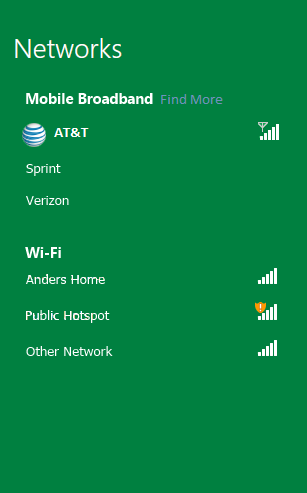Windows 8 Mobile Broadband Enhancements Detailed
by Andrew Cunningham on January 20, 2012 3:30 PM ESTUsing mobile broadband in Windows 8 will no longer require specific drivers and third-party software, says Microsoft's Billy Anders in a Building Windows 8 blog post today. This is thanks to the new Mobile Broadband Interface Model (MBIM) standard, which hardware makers are reportedly already beginning to adopt, and a generic driver in Windows 8 that can interface with any chip supporting that standard.
We've known for awhile now that mobile broadband chips would be treated as first-class devices in Windows 8 - the same as wi-fi, ethernet, Bluetooth, and USB 3.0, among others - but as usual Microsoft's blog post discusses the subject in exhaustive detail: because of their new first-class status, broadband antennas can be turned on and off in the same way that wi-fi and Bluetooth now are, and Airplane Mode can turn all of it off in one swoop, just like on a smartphone (see above). As on phones, Windows will automatically prioritize wi-fi networks when both wi-fi and cellular are available.

If your laptop or tablet has a SIM card installed, Windows will automatically detect which carrier it's associated with and download any available mobile broadband app from the Windows store, and carrier-unlocked laptops and tablets can choose between multiple cellular carriers if the hardware supports it (see above). As Brian noted in our first Windows 8 overview, the operating system also offers estimated data usage figures when connected to cellular networks, and the OS will adjust its default behaviors to save on data (for example, deferring automatic downloading and installing of Windows updates until wi-fi is available).

For people using wired or wi-fi connections that are also metered, Microsoft also gives you the option to see data usage figures for these networks. By selecting a "reduce data usage" option, Windows will use new built-in APIs to force network-aware Metro apps to use less data when possible (another example: using a low-bandwidth movie stream rather than a high bandwidth one). Network-aware Metro apps are required to use these APIs, and users can check how much bandwidth apps are using (both on metered and non-metered networks) in the Task Manager (above).
Lastly, Microsoft has made changes to the networking stack in Windows to allow for faster wi-fi connections when devices wake from sleep - information such as your preferred network list and other "hints" provided to your wi-fi adapter mean that wi-fi connections will be available "about a second" after the device wakes up.
That about covers all of the good stuff, but as always you can check the source post for more information. The Windows 8 beta is expected in February, with a final release targeted for sometime before the end of 2012.
Source: Building Windows 8 blog










14 Comments
View All Comments
Brian Klug - Friday, January 20, 2012 - link
That's odd, I'm fairly certain that Windows 7 already has some built-in mobile broadband card support. I just noticed this kicked in on my Pantech UML290 on VZW LTE with the latest firmware update: http://twitpic.com/88a3o8-Brian
Andrew.a.cunningham - Friday, January 20, 2012 - link
They were pretty sketchy in the post on what support was already included in Windows 7, and I'm sure it depends on the specific device you're using - either way, the focus in Windows 8 is on enhancing and standardizing that experience. I'll change the headline to be a bit less ambiguous about that...Brian Klug - Friday, January 20, 2012 - link
Yeah, I mean obviously the new data metering per application features are new, along with the preferences for background data and such. Those are indeed very cool in Win 8.It's odd though because the class driver/support for some datacards has existed for a while across OS X/Linux/Windows - probably one of the only good things about using AT+ commands for so long is that most of the support is generic.
-Brian
B3an - Saturday, January 21, 2012 - link
While Win7 has some kind of support for this you cant use mobile broadband on Win7 without 3rd party drivers, and sometimes software as well. On Win8 theres no need for either, as it supports the Mobile Broadband Interface Model (MBIM) specification. Win 8 uses a single built-in driver that works with all mobile broadband hardware and providers and this driver is kept up to date with Windows Update.dagamer34 - Friday, January 20, 2012 - link
Hurray for built-in support and no proprietary management apps required. I just hope that Windows 8 supports tethering via Bluetooth from a smartphone in the same integrated way and that these data management techniques work there too.Sadly though, I think buying non-smartphone devices with integrated mobile broadband isn't ideal under the current plan structure which makes you pay at least $20/month per device for a connection when tethering plus a large bucket of data is a much better option right now. Maybe that'll change when every device gets built in 3G, but for now, the plans are too costly.
bah12 - Friday, January 20, 2012 - link
Not, quite. Rather now it will auto-download said proprietary apps."If your laptop or tablet has a SIM card installed, Windows will automatically detect which carrier it's associated with and download any available mobile broadband app from the Windows store,"
inighthawki - Saturday, January 21, 2012 - link
An app from the windows store is much different than the proprietary software required to use the device. Apps from the windows store, if i recall correctly, are metro apps, so they will most likely be the apps they have on phones where you can query account status or data usage, possibly pay bills, etc. They wont be required to use the device itself.B3an - Friday, January 20, 2012 - link
Been following the MS Windows 8 blog and i'm actually quite amazed at all the new stuff in Windows 8 and it's not even all been announced yet. It's by FAR the biggest update to Windows since the release of Windows and everything they're doing with it looks great. I wont even consider a tablet without Win8 on it.Ultimate device: Win8 tablet + 1080p PLS / IPS screen + Keyboard dock with extended battery, card reader, HDMI and/or DP out.
Would totally replace my laptop, and i could connect it to my 30" monitors whenever i wanted making it work like any other PC.
Duraz0rz - Friday, January 20, 2012 - link
I think the real question is how well the Metro UI works with traditional input devices. No doubt it's a great design for handheld devices like smartphones and tablets, and it would be interesting to see a touchscreen built into full-fledged notebooks. But I don't see how well it will work for desktop users.But I guess that will be answered when Windows 8 goes into public beta.
B3an - Saturday, January 21, 2012 - link
I've already been using the Developer Preview for two months and for me i stay on the usual desktop UI for 98% of the time. With touch devices i'm sure it will be the total opposite though, but thats the great thing about W8. Two UI's that suit all needs.The only time i ever really use Metro with mouse/keyboard input was when searching through programs (or "apps" as they now call them) because the Metro UI also replaces the Start menu. Theres a few other small things too but overall the desktop hasn't changed too much, and i'm liking the updated Aero theme.